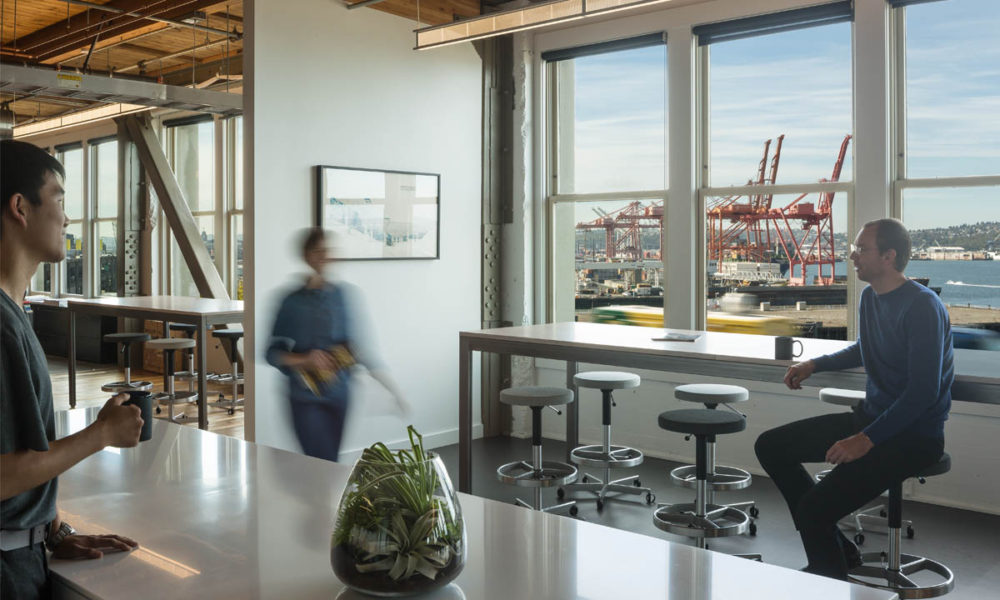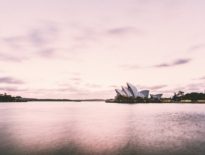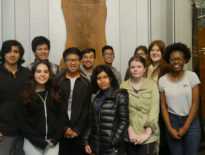Built on the values and principles of sustainability, forty years ago Dave Miller and Bob Hull founded a firm that has led the way in creating architecture that responds to and respects its natural surroundings. The Miller Hull Partnership continues this founding tradition as they are involved with a number of Living Buildings that push the boundary of efficiency, including the recently completed Bullitt Center–the largest and first commercial certified Living Building regarded as ‘the greenest building in the world’. When it came time for Miller Hull to renovate its own studio, the Living Building Challenge was the right path to represent firm values.
After thirteen years of occupying 14,000 SF in the historic Polson Building in Pioneer Square, The Miller Hull Partnership decided it was time to rethink their space, starting with the oversized drafting tables they had been using for more than 30 years. In order to stay in the location they loved and grow the firm without adding square footage, it was necessary to reduce each employee’s personal real estate. The reduction in personal workstation area was balanced by large, open meeting spaces augmented with pin-up walls and technology to optimize collaboration. The new studio is a reflection of who they are as design professionals. They are inspired by site, particularly by “the unparalleled views of Seattle, Elliott Bay and Puget Sound, and the Olympic Mountains, all of which are the stars of our space,” according to the design team. “We are programmatically innovative and opted to not follow the trend of giving everyone an adjustable sit-stand desk, but rather provided alternative places for working which encourages people to move around,” said Principal Margaret Sprug.

The goal of the project was to create a flexible open workplace that fosters collaboration and innovation, reflects the highest environmental design standards, highlights the site’s unique attributes, is timeless, and provides a place where Miller Hull’s diverse clientele can be inspired to collaboratively create unique solutions that are specific to their needs and a reflection of who they are. The design is simple and allows for unencumbered design thinking by avoiding large-scale gestures, playful lounge zones, or ad-hoc décor. Instead, the design enhances the outstanding features of the space, such as open perimeter workstations that preserve views and natural light. This allows the project to make their only achievement in the Health & Happiness Petal with the Civilized Environment Imperative. New skylights bring daylight to the center of the space where existing walls could not be changed. Existing exposed heavy timber structure and salvaged wood floors combine with a neutral color palette to ground the space in nature.
Working within the limits of a Tenant Improvement, the project team could not feasibly pursue the Net Positive Energy and Water Petals of the Living Building Challenge, but was able to achieve great energy performance. Through careful design, the team attained an installed lighting power density of 0.25 W/SF. This compares to 2012 code limit of 0.90 W/SF for offices. This project shows that reaching well beyond the 2018 code requirement is financially viable today. Between lighting reduction, occupancy sensors, and new energy efficient systems, the team reduced the EUI of the space from 55 to 45.
Other notable metrics include:
- 88% savings in lighting electricity use
- 25% savings in plug load electricity use
- 22% overall savings in electricity use
- 19% overall savings in energy use
- New EUI of 45
- Savings over 2030 Challenge: 37.5%
The Miller Hull Partnership work space marks two significant milestones for the Living Building Challenge. It is the 50th project to achieve certification, and is the first project to certify under v3.1 of the Living Building Challenge.
VITAL STATS
| Certification Status | Petal Certified |
|---|---|
| Version of LBC | 3.1 |
| Location | Seattle, WA, USA |
| Typology | Renovation |
| Project Area | 14,092 SF |
| Start of Occupancy | July 2016 |
| Owner Occupied | Yes |
| Occupancy Type | Office |
| Number of Occupants | 85 |
PROJECT TEAM
| Owner | The Miller Hull Partnership |
|---|---|
| Designer | Ron Rochon, Margaret Sprug, Kristin Kelsey, Matt Kikosicki, Becky Roberts, Christine Traber |
| LBC Project Manager | Chris Hellstern |
| Architect | The Miller Hull Partnership |
| Contractor | Turner Construction Company |
| Mechanical | McKinstry (design/build) |
| Lighting Design | Luma Lighting Design |
| Interior Design | The Miller Hull Partnership |
| Key Subcontractors | Master Millwork, McKinstry, Titan, Division 9, Pepperbox, 12th Avenue Iron |
SITE INFO
This project is a renovation of the sixth floor of an historic building in downtown Seattle’s Pioneer Square neighborhood. There is no exterior scope of work to this project.
03. HABITAT EXCHANGE
The very nature of Miller Hull’s business requires the use of land, and the Habitat Exchange Imperative provides the firm a way to offset this unavoidable reality. Although many of the firm’s projects strive to build upon previously developed sites in the effort to protect virgin land, ultimately their clients provide the location for the architecture. For their own remodel of an entire floor in the Historic Polson Building, Miller Hull is proud to have preserved and restored a piece of Seattle’s history for continued use.
When selecting a piece of land for the Habitat Exchange, Miller Hull had three chief desires:
- Selection of an approved Land Trust that Miller Hull supports
- Selection of a local parcel
- Selection of public property that Miller Hull staff could visit
Through Forterra, an organization that Miller Hull has long supported through financial and volunteer work, the firm found a piece of undeveloped shoreline on Anderson Island in Puget Sound. The Habitat Exchange helped Forterra to secure 18-acres of land that supports a delicate ecosystem of marine forest that is home to fish and wildlife including salmon, marine mammals, and shellfish. A system of trails provides public access to this important ecosystem in Puget Sound.
10. RED LIST
The team found the Materials Petal to be challenging, despite having experience with these Imperatives from previous Living Building Challenge certified projects. From the outset of the project’s design, the team had two beneficial project stipulations that would help achieve this Petal. First, a list was created of building products and furniture that the team planned to reuse. Some of these major items included wood flooring, ductwork, some furniture and equipment. Second, the team’s design aesthetic had the benefit of using few finish materials.
The specifications started with products referenced from the Bullitt and Bertschi Living Building projects, which gave a base of materials from which to design. However, as collection of documentation began, the team faced some resistance from both manufacturers and subcontractors who were reluctant to provide the necessary documentation. In fact, there were some companies who, after providing acceptable information to document Red List compliance for materials used in previous Living Buildings, refused to provide the proper documentation a second time.
As the first team to have successfully certified a project under version 3.1 of the Living Building Challenge, they faced new hurdles including additional Red List ingredients, products requiring more thorough vetting, and documentation requirements. For example, hexavalent chromium presented a difficulty in regards to metal stud framing. The team was unable to source any hexavalent chromium-free steel coil because large minimum order tonnages were required. Because the team needed to frame only a few spaces in the mostly open plan studio, the required quantity was well under the tens of tons that three different manufacturers required in order to eliminate this toxic passivation coating. They explored alternatives and reengineered and redrew documents to provide a wood structure instead of the metal studs. Sourcing the FSC lumber needed for this approach was unsuccessful, and transporting the large wood framing members into the building to the 6th floor presented an additional hurdle that would have needed to be overcome. A third option was to use reclaimed metal studs from another office renovation in Seattle that the contractor was working on. Unfortunately, they were not able to source all the members needed. Additionally, the available members were not in the condition required to make the salvage work. Ultimately, the team was forced to use the hexavalent chromium studs and advocate with the manufacturers to eliminate hexavalent chromium from their products. However, the team found much more success in avoiding hexavalent chromium in metal coils for the custom-made ductwork.

The ceiling registers and diffusers also had an issue with regard to the Red List requirements that the team was able to work around. Surprisingly, BPA was an ingredient in the manufacturer-supplied powder coating. The manufacturer was unwilling to eliminate BPA from this coating, so the team specified a mill-finished product and hand painted the products with a compliant paint.
On the other hand, the team had great success with a major furniture manufacturer with the same issue. The foot ring on one of their stools, that was otherwise completely LBC Red List free, contained BPA in the powder coating. When this was discovered, the manufacturer was very willing to find an alternative. The team did some research and found what might be the only BPA-free powder coating from the world’s largest powder coating supplier. They passed this information to the furniture manufacturer who then changed their coating to create a fully Red List compliant stool.
Finish products were another hurdle the team had to overcome to meet the Red List requirements. The design requirements called for a product to coat both steel and wood while still meeting the Living Building Challenge’s VOC and Red List requirements. The team researched paints, stains and dyes finally receiving a compliant product recommendation from a local expert. The compliant product was used for both wood finish and steel clear coat protectant, had extremely low VOC content and did not contain any Red List ingredients.
Like any LBC project, complex equipment and lighting were difficult to vet for Red List compliance. The team was surprised at how arduous it was to get information from manufacturers. Several appliance manufacturers withheld ingredients, saying that they are only legally bound to disclose ingredients under California’s Proposition 65 warning. For lighting, the team found a great company that worked with them to disclose as much information as possible, outlining the Restrictive of Hazardous Substances (RoHS) and Registration, Evaluation, Authorization and Restriction of Chemicals (REACH) compliance for each component within the system. However, their product line was limited and unfortunately did not include all the fixtures that the studio design required. Ultimately, they found that many companies needed education on what to look for in their various components and were not familiar with the European RoHS standard.

“BUT WHILE THERE ARE NUMEROUS STORIES OF DIFFICULT DISCUSSIONS WITH MANUFACTURERS AND DEAD ENDS WITH TRANSPARENCY REQUESTS, THERE ARE SOME GREAT SUCCESSES AS WELL. THE MARKET HAS MADE SIGNIFICANT TRANSFORMATION IN THE PAST FEW YEARS FROM WHERE IT WAS DURING SOME OF OUR FIRST LIVING BUILDING CHALLENGE WORK.”
– CHRIS HELLSTERN
Many manufacturers have now heard of the Living Building Challenge and the Red List and are working to help disclose their ingredients. The furniture industry is leading the way by working with designers to make the product line changes needed to comply with Red List requirements. Some manufacturers even catalogue their entire product lines as Red List compliant, having identified their ingredients. They disclose the offending ingredients and solicit feedback and encourage teamwork to find a substitute ingredient. Products including furniture, carpet, paint, gypsum board and insulation have transparency documentation from Declare Labels to Health Product Declarations available. Compared to just a few years ago, there are often many choices for a particular product that can be LBC compliant. There is great hope; the industry continues to evolve as owners and designers continue to demand healthier products and the disclosure of all ingredients.
11. EMBODIED CARBON FOOTPRINT
Whether it is the cement content of a huge infrastructure project or the reuse of materials in an office space, Miller Hull always considers the embodied carbon of its project work. One of the primary material approaches for the studio space was to reuse as much of the existing materials as possible. However, typical architects’ offices have an open floorplan and very few walls. This was the case with Miller Hull’s space even prior to the remodel work, which limited opportunities for reuse.
Some of the existing materials that the team reused included salvaged wood flooring, existing structure, and most of the ductwork and even window shades. In addition to reusing existing materials, the team worked to eliminate superfluous materials such as cable tray, ceilings, partitions and more.
The team made a diligent effort to ensure the majority of materials originated near the site. Apart from a few unavoidable metal studs, the majority of the structural members were extremely low-carbon glue-laminated beams or columns. Minimal use of gypsum board and other finishes helped to keep the overall carbon footprint low. The embodied carbon calculation in the Athena Impact Estimator concluded a rather low amount of embodied carbon for this construction, as expected. Ultimately, the team went above and beyond the offset requirements, adding a few extra tons to their final carbon offset.
12. RESPONSIBLE INDUSTRY
Being in the Pacific Northwest, the team assumed they would have sufficient access to an FSC lumber supply. Despite having difficulty with this on previous LBC projects in Seattle a few years ago, they had hoped that the market had improved. Sadly, they were disappointed to learn the lack of progress. Given the relatively small scope of the TI project, they were unable to locate all the FSC wood required. As a result, when plywood was needed, it was easier for the contractor to use a salvaged piece of lumber rather than try to procure something FSC and the team ended up using metal studs due to lack of FSC studs in the local market.
The team was able to source some FSC Certified wood for the project, while all remaining wood was salvaged. FSC wood was sourced from Matheus Lumber in Woodinville, WA.
ALL DECLARE PRODUCTS
- 06 40 00 Resilient Surface Forbo Marmoleum
- 08 11 30 Openings Trio-E Hollow Metal Door
- 09 25 00 Finishes Georgia Pacific Type-X GWB
- 09 60 00 Finishes Interface Modular
- 09 60 00 Finishes Forbo Resilient Flooring
- 09 68 00 Insulation Knauf Eco-Bat Kraft Faced
- 10 00 00 Specialty Coating Idea Paint
- 12 24 13 Furnishings Mecho Shade

13. LIVING ECONOMY SOURCING
Final percent of total budget sourced from each zone:
- 500 km radius 62.82%
- 1000 km radius 1.1%
- 5,000 km radius 27.02
- Any Radius 9.06%
Notable regional products specified:
- Glulams — Calvert Glulams,
- Portland Oregon
- Crystallite Skylights, Everett, Washington
- Gypsum Board — Georgia Pacific, Tacoma, WA
- Custom Desks and casework — Pepperbox & 12th Avenue Iron, Seattle, WA
- Lighting — Fluxwerx, Vancouver, BC
14. NET POSITIVE WASTE
Miller Hull took great care and effort to salvage the majority of the existing finishes, equipment and furniture from the existing space prior to demolition. To do this, an extensive audit was completed that catalogued each item for reuse. Priority of salvage was given to Miller Hull staff, family and friends before soliciting others in the community. Over 40 unique items in addition to light fixtures were donated. Items included bookcases, shelving, casework, appliances, wall coverings, trim work and more.
Whenever possible, materials were reused or reclaimed for use on the project. While the team salvaged a few notable items for reuse in this project, many of the salvaged materials were donated to various organizations throughout the region.
WOOD FLOORING
The wood flooring has been reused from Miller Hull’s previous tenant improvement more than ten years ago. During that project, the wood flooring was acquired as salvaged lumber from the southeast United States. The design and construction team took great care to reuse this material for the current tenant improvement, which saved a great deal of new flooring material.
ACOUSTIC INSULATION
Most of the insulation that was removed from existing demolished walls was reused in the new wall assemblies in the project. While this salvage did not account for all the required insulation for the new design, it did account for a majority, which significantly reduced the amount of new insulation required.
SALVAGED PLYWOOD
The contractor had access to salvaged plywood, which had various applications including blocking and floor underlayment.
FURNITURE
While some of the existing furniture and casework no longer met the studio’s functional needs, the team was able to salvage some tables, filing cabinets and other storage items for reuse. The remaining salvaged furniture was donated to various organizations around Seattle.
DOORS
Several doors were reused in this project.
STEEL ANGLE & HOMASOTE
The previous studio design made use of steel angle for various trim pieces around pin‐up space. These were reused to frame the reused Homasote panels for project pin‐up space.

17. EQUITABLE INVESTMENT
Although not a typical component of many of the projects Miller Hull undertakes, the Equitable Investment portion of this project was deemed a high priority. For many years, Miller Hull has supported its community and issues the employees care about through charitable contributions. Some of the causes that Miller Hull supports include professional organizations related to architecture and art, community causes like Habitat for Humanity and United Way, environmental organizations to preserve and restore land, educational endowments for scholarships as well as other originations that are close to their hearts.
In 2015 alone, Miller Hull gave a significant amount to support these organizations that help to improve communities. The amount given far-exceeds the .5 cents per project dollar required by the Living Building Challenge. What’s more, Miller Hull will contribute nearly this amount again next year, as charitable giving is a foundational part of this firm’s annual operations.
18. JUST ORGANIZATIONS
The Miller Hull Partnership has a JUST label; a voluntary and transparent social equity disclosure program.
View their label here.
19. BEAUTY + SPIRIT
The goal of the project was to create a flexible open workplace that fosters collaboration and innovation, reflects the highest environmental design standards, highlights the site’s unique attributes, is timeless, and provides a place where Miller Hull’s diverse clientele can be inspired to collaboratively create unique solutions that are specific to their needs and are reflections of their identities. The design is simple and without the pretense of being on the cutting edge. The design refrains from large-scale gestures, playful lounge zones, or ad hoc décor.
The firm believes the design enhances the outstanding features of the space. Open perimeter workstations preserve spectacular, unobstructed views of Elliott Bay, Puget Sound and the Olympic Mountains and welcome abundant natural light. New skylights bring daylight to the center of the space along the building’s structural wall. The existing, exposed heavy timber structure and salvaged wood floors combine with a neutral color palette to ground the space in nature and provide an environment that does not compete for attention as the firm works to design for others.
Each workstation, meeting, gathering, and collaborating space is directly, naturally lit, enhancing wellbeing and productivity. In order to encourage healthy movement throughout the workday; storage, supplies, printers, copiers, and design and materials libraries are centralized. Counter height collaboration tables allow people to reposition how they work.
The old galley kitchen was buried in the middle of the space without natural light or a place to sit. The new kitchen was enlarged and relocated to the perimeter to provide everyone access to the best views in the studio.
A large kitchen table now provides a place for colleagues to take a break from their computers and enjoy a conversation and a meal together.
Miller Hull also included artwork around the studio that was made by its founding partner, Bob Hull.
“BOB WAS SO CREATIVE AND ALWAYS DRAWING, MAKING THINGS AND HE HAD AN AMAZING WAY OF BALANCING MAKING SERIOUS ARCHITECTURE, WITHOUT BEING TOO SERIOUS. MANY OF THE THINGS HE MADE WERE FUN AND NOT TOO PRECIOUS AND WE WANTED TO INCLUDE THESE ITEMS IN OUR OFFICE TO REMIND US OF THE FUN, EASY GOING SPIRIT HE BROUGHT TO THE OFFICE CULTURE.”
– LAUREN KEENE
THE BIRDS
The birds are full-scale models that Bob made just for fun. The largest of these birds was always above his desk. The design team decided to include these in the studio because the bird theme was also a part of Bob’s sketches.
“IF YOU LOOK THROUGH THE HUNDREDS OF SKETCHES WE HAVE OF HIS, YOU WILL NOTICE THAT IN ALMOST EVERY ONE HE DRAWS LITTLE BIRDS. IT WAS ONE OF THE SIGNATURES OF ‘A BOB SKETCH’, A TERM THAT WAS KNOWN AROUND THE STUDIO AS THE SKETCH THAT WOULD TELL THE STORY OF A PROJECT IN A SINGLE IMAGE.”
– LAUREN KEENE
THE PRINT
Bob made this large-scale screen print right after he returned from Afghanistan, where he volunteered in the Peace Corps. He went there right after school, to pre-Taliban, optimistic Afghanistan when women could go to school, wear skirts, listen to music or make art. There, he designed and built a ministry of tourism, a building that still stands to this day. When Bob returned to Seattle from this trip, he was just 27 years old.
The print itself is printed in silver metallic ink on a dyed blue canvas and is made using two small screens (about 12 x 18) that repeat an Afghan inspired pattern across the 6’ x 7.5’ canvas. The sides of the canvas are painted by hand and extend the Afghan pattern to morph it into a more geometric pattern relating to a computer chip. Combining traditional methods with science and technology was a theme to Bob’s work and process. He always looked to everyday solutions and elevated them through innovation.
Miller Hull feels the design is a reflection of the type of architecture that it has designed since its inception. At the heart of the firm’s work is a connection to the power of natural surroundings. Their legacy of environmentally responsible buildings is inspired by the efficiency and elegance of passive systems and regional materials. Miller Hull leverages the openness and flexibility of modernist form to celebrate connections inside and out.




